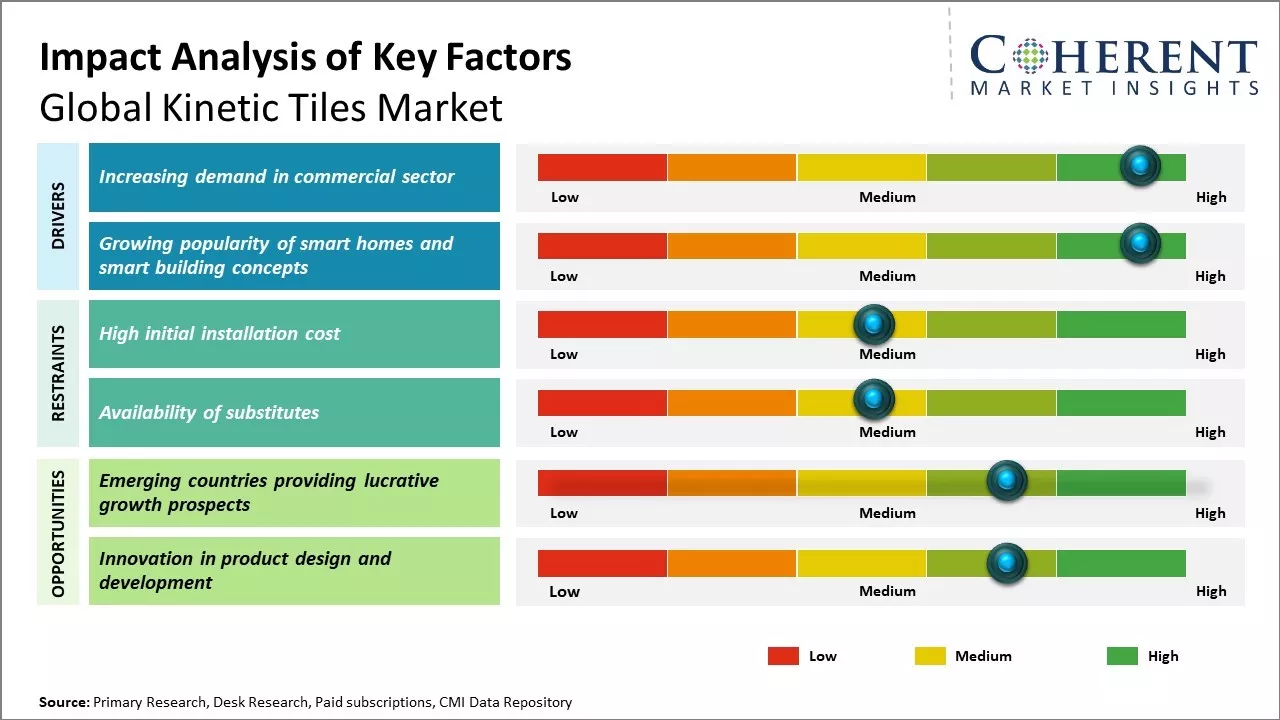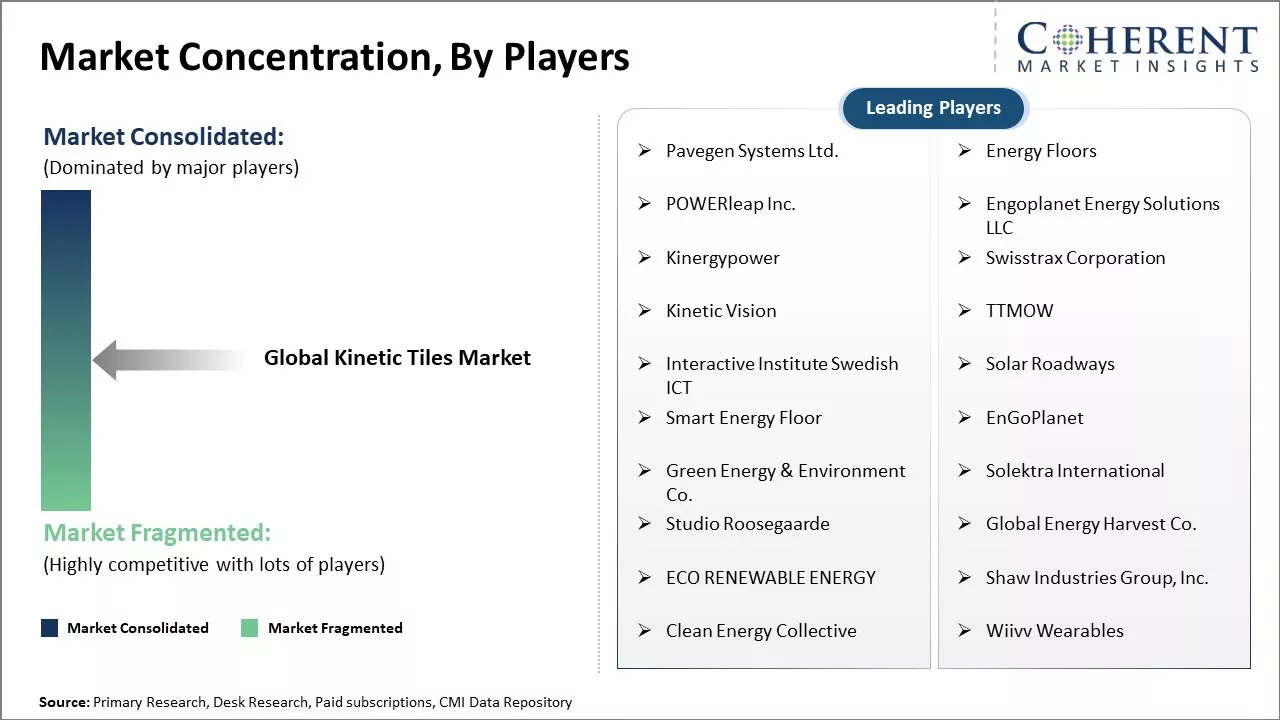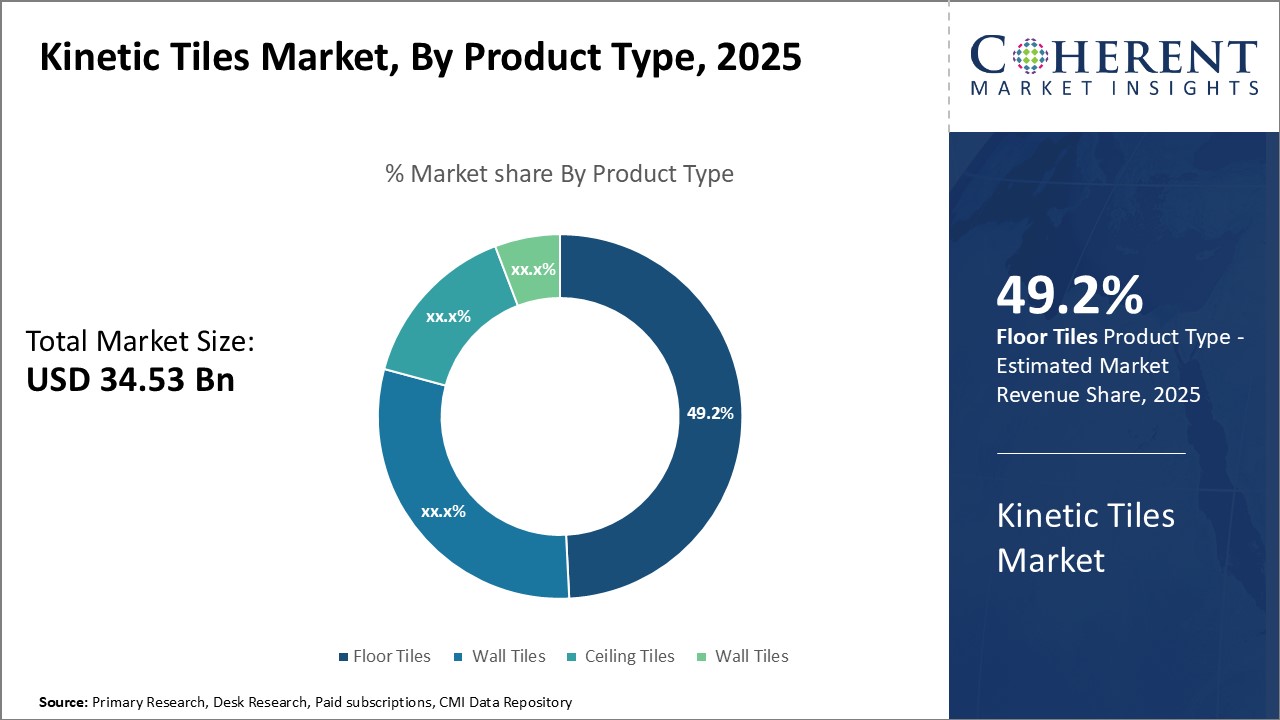Kinetic Tiles Market Size and Trends
The global kinetic tiles market is estimated to be valued at USD 34.53 Bn in 2025 and is expected to reach USD 47.66 Bn by 2032, exhibiting a compound annual growth rate (CAGR) of 4.7% from 2025 to 2032.

Discover market dynamics shaping the industry: Download Free Sample
Rapid urbanization coupled with increasing demand for innovative architectural designs from the commercial sector is expected to support the demand for kinetic tiles, according to data by Invest India in 2022, The construction Industry in India is expected to reach US$1.4 Tn by 2025. Additionally, growing focus of architects on kinetic facades to address issues like natural daylighting and ventilation is further anticipated to drive the market growth. Kinetic tiles allow dynamic shading and reduce overheating since the tiles can be reconfigured or transformed in different angles to manage or optimize daylight and ventilation. Rise in commercial construction and infrastructure projects worldwide presents growth opportunities for vendors engaged in kinetic tiles during the forecast period. However, high initial costs of kinetic tiles as compared to conventional building materials may hamper the market growth to some extent over the forecast period.
Market Driver - Increasing demand in commercial sector
The commercial real estate sector has been thriving across major cities worldwide. For instance, according to data by IBEF in 2021, the real estate sector in India is expected to reach USD 1 trillion in market size by 2030. With more and more companies setting up offices across various industries, the need for innovative office spaces has risen tremendously. Traditional tile floors are highly unsuitable for commercial areas that see heavy foot traffic on a daily basis as they easily get damaged. Kinetic tiles have emerged as a sustainable alternative to solve this issue. Made of durable materials like porcelain and natural stone composite, these movable floor tiles are extremely resilient against wear and tear. They also allow for easy reconfiguration of office spaces whenever the need arises without major construction work.
Many large corporations such as Pavegen Systems Ltd., Energy Floors, POWERleap Inc., are actively remodeling their office infrastructure with kinetic tiles to optimize workspace utilization. Their modular interlocking design enables quick rearrangement of desks, workstations and floor plans according to changing project or team requirements. This boosts productivity and collaboration within office premises. Kinetic tiles have minimum lifecycle costs as they do not need frequent replacement unlike rigid flooring. Moreover, their maintenance involves simple periodic cleaning without extensive repairs. Several companies such as Pavegen Systems Ltd., Energy Floors, are also installing them in high traffic lobby areas, cafeterias, pantry sections and lounge spaces to withstand heavy usage. As commercial real estate portfolio expands globally, the incorporation of innovative flooring solutions will grow in tandem to suit dynamic office needs.
Market Concentration and Competitive Landscape

Get actionable strategies to beat competition: Download Free Sample
Growing popularity of smart homes and smart building concepts
With rapid digital transformation, there is rising consumer inclination towards intelligent home automation solutions. Smart homes integrate various electronic devices and appliances that can be remotely operated or programmed through an application. This provides enhanced comfort, security and energy efficiency to homeowners. Kinetic tiles have emerged as a core component for constructing futuristic smart buildings as they come embedded with smart technology. These tiles have sensors to detect occupancy, collect foot traffic data and activate automation accordingly. For instance, they can adjust temperature, lighting and airflow based on presence detection.
Many kinetic tile models include Bluetooth or Wi-Fi connectivity to partner with virtual home assistants for command and control. Homeowners can give voice commands to rearrange furniture layout, monitor for any tile displacement through a mobile app. This serves elderly residents who require easy living assistance. Such smart building concepts are gaining popularity for their convenience and personalized experience. Even commercial structures are incorporating these solutions for amenity management. As more households and global population adopt smart home devices in coming years, demand for multifunctional kinetic tiles will grow significantly. Their use will accelerate modern construction of automated, adaptive living spaces tuned to user needs.
Key Takeaways from Analyst:
The demand for these tiles is growing mainly due to increasing awareness about benefits of indoor activities. Kinetic tiles allow small physical movements indoors which is important for good health. This drives more people to opt for these tiles to stay active even while sitting or standing for long periods. Additionally, the growing popularity of fitness culture is encouraging people to include such tiles at homes, offices as well as public places like malls and transit stations.
However, the growth of this market could be restricted by the higher costs of kinetic tiles compared to regular floor tiles. This might limit their uptake, specifically in price sensitive regions. Availability issues in certain areas may also impact the market growth negatively.
North America is currently the dominant region and is expected to continue its lead supported by rising health consciousness. Asia Pacific will likely emerge as the fastest growing regional market owing to rapid urbanization, increasing fitness awareness and economic growth in countries like China and India. Key players could focus on tapping into opportunities in Asia Pacific region through expanding distribution networks.
Market Challenge - High initial installation cost
One of the major challenges faced by the global kinetic tiles market is the high initial installation cost associated with these products. Kinetic tiles require specialized equipment and expertise for their installation which drives up the overall costs. Additional site preparation work such as leveling of surface and ensuring appropriate drainage systems are also needed. This makes the total installation expenditure for kinetic tiles significantly higher than traditional flooring solutions such as carpets, wooden flooring or ceramic tiles. The cost barriers restrict the adoption of these products among budget-conscious customer segments. Manufacturers need to explore strategies such as value engineering to lower production costs and bring down the pricing to some extent in order to drive wider market acceptance. Subsidies and financing schemes specially designed for green construction projects can also help address the affordability challenges surrounding kinetic tiles installation.
Market Opportunity - Emerging countries providing lucrative growth prospects for market
The global kinetic tiles market sees emerging countries as a key opportunity area for future growth. Rapid urbanization and industrialization in developing nations has boosted infrastructure spending on commercial construction which acts as the main end-user for these products. Factors such as rising environmental awareness, supportive government policies and growing focus on energy efficiency are encouraging the use of green building materials including kinetic tiles. Additionally, populations in developing regions are getting more affluent which is driving the demand for aesthetically appealing and high-performance flooring solutions. Countries across Asia Pacific, Latin America, the Middle East, and Africa with fast growing construction industries thus present significant untapped market potential. Market players need to invest in customizing their product portfolios and distribution strategies to better cater to the specific needs of customers in these geographies.

Discover high revenue pocket segments and roadmap to it: Download Free Sample
Insights by product type: Ease and longevity of kinetic tiles
In terms of product type, the floor tiles segment is expected to contribute 49.2% share of the market in 2025, owing to their unique ability to provide utmost comfort along with enduring durability. Floor tiles are designed to withstand constant foot traffic while offering a soft surface feel. Their resilient construction makes them highly durable for withstanding the pressures of daily use without showing signs of damage. The wide variety of designs, textures and surface patterns further enhance the comfort quotient. Being slip and skid resistant, they also ensure safety. Their low maintenance needs coupled with long operational lifespan drive considerable cost savings for both homeowners and commercial users over time.
Insights by material: Visual attractiveness and adaptability of kinetic tile
In terms of material, ceramic is expected to contribute 33% share of the market in 2025, owing to its unparalleled aesthetic appeal and versatility. Ceramic tiles are renowned for their timeless beauty and ability to complement varied architectural styles. With new designs and glazing techniques emerging frequently, they allow unlimited possibilities for creative expression. Their dense composition also makes them highly durable and robust against harsh conditions. Being water resistant, stain proof and non-porous, ceramic tiles require minimum upkeep. They are suitable for both indoor and outdoor applications across residential and commercial settings. Their affordable cost and easy installation further boost their widespread preference.
Regional Insights

Need a Different Region or Segment? Download Free Sample
North America has emerged as the dominant region in the global kinetic tiles market. The region is expected to hold 32.0% of the market share in 2025. This can be attributed to high awareness levels among builders, architects, and homeowners regarding the benefits of kinetic tiles. Many leading tile manufacturers such as Engoplanet Energy Solutions LLC and other have a strong presence in the U.S. and Canada, allowing for ease of access. Customers in the region are willing to pay a premium for innovative products that enhance functionality and aesthetics.
Stringent building regulations that promote sustainability and energy efficiency have also propelled demand. Federal grants and tax incentives are boosting large-scale commercial and institutional projects utilizing kinetic tiles. Moreover, North American exporters are leveraging their technological edge to tap markets in Europe and Asia Pacific. Their presence across major online and offline retail channels helps establish a robust supply chain.
The Asia Pacific region has been witnessing double-digit growth and is forecasted to be the fastest expanding kinetic tiles market in the coming years. Rapid urbanization and infrastructure development are driving the need for next-gen construction materials. There is a growing middle-class population with rising disposable incomes and changing preferences towards aesthetically appealing interiors.
Indonesia, India, Thailand, and Vietnam in particular are investing heavily in commercial real estate and special economic zones. This has prompted international tile manufacturers to establish local production capabilities or form joint ventures to capitalize on the opportunity. Significant imports from China and Turkey are also meeting the surging demand. As specifications in the construction industry evolve, uptake of kinetic tiles is expected to rise manifold.
Market Report Scope
Kinetic Tiles Market Report Coverage
| Report Coverage | Details | ||
|---|---|---|---|
| Base Year: | 2024 | Market Size in 2025: | USD 34.53 Bn |
| Historical Data for: | 2020 To 2024 | Forecast Period: | 2025 To 2032 |
| Forecast Period 2025 to 2032 CAGR: | 4.7% | 2032 Value Projection: | USD 47.66 Bn |
| Geographies covered: |
|
||
| Segments covered: |
|
||
| Companies covered: |
Pavegen Systems Ltd., Energy Floors, POWERleap Inc., Engoplanet Energy Solutions LLC, Kinergypower, Swisstrax Corporation, Kinetic Vision, TTMOW, Interactive Institute Swedish ICT, Solar Roadways, Smart Energy Floor, EnGoPlanet, Green Energy & Environment Co., Solektra International, Studio Roosegaarde, Global Energy Harvest Co., ECO RENEWABLE ENERGY, Shaw Industries Group, Inc., Clean Energy Collective, and Wiivv Wearables |
||
| Growth Drivers: |
|
||
| Restraints & Challenges: |
|
||
Uncover macros and micros vetted on 75+ parameters: Get instant access to report
Kinetic Tiles Industry News
- In 2023, Mr. Laurence Kemball-Cook, the Founder and CEO of Pavegen, continues to lead the charge in innovative energy solutions through his company, which harnesses kinetic energy to generate off-grid electricity. After an impressive journey that includes the development of over 700 prototypes and more than 250 installations across 37 countries, Pavegen is poised for its next phase of growth with the launch of a new crowdfunding campaign aimed at attracting fresh investment.
- In 2023, Somany Ceramics, one of India's leading tile manufacturers, launched a new range of luxury tiles to cater to the growing demand for high-end, premium tiles in the Indian market. The new collection, named "Somany Signature," features a wide variety of designs, sizes, and finishes that offer unparalleled elegance and sophistication to interior spaces.
- In March 2021, introduced Eco-Gres 2.0, an innovative collection of eco-friendly tiles designed to meet the growing demand for sustainable building materials. Made with up to 60% recycled content, Eco-Gres 2.0 reflects Centura's commitment to environmental responsibility while providing stylish options for various design needs.
- In 2020, Johnson Tiles, a leading manufacturer of tiles, launched its innovative Eco-Tile range, offering a sustainable alternative to traditional tiles. These eco-friendly tiles are made with up to 98% recycled content, significantly reducing their environmental impact and contributing to the growing demand for sustainable building materials.
*Definition: The global kinetic tiles market involves tiles that have motion and movement features built directly into their design and functionality. These innovative tiles harness kinetic energy from footsteps, wind, or other sources and convert it into small amounts of renewable electricity. They are often used decoratively on floors, walls, and other surfaces both indoors and outdoors. As renewable energy technologies advance, the global kinetic tiles market has seen rising interest from architects, designers, and homeowners looking for novel ways to generate clean power.
Market Segmentation
- By Product Type Insights (Revenue, USD Bn, 2020 - 2032)
-
- Floor Tiles
- Wall Tiles
- Ceiling Tiles
- Wall Tiles
- By Material Insights (Revenue, USD Bn, 2020 - 2032)
-
- Ceramic
- Vinyl
- Glass
- Others
- Regional Insights (Revenue, USD Bn 2020 - 2032)
-
- North America
- U.S.
- Canada
- Latin America
- Brazil
- Argentina
- Mexico
- Rest of Latin America
- Europe
- Germany
- U.K.
- Spain
- France
- Italy
- Russia
- Rest of Europe
- Asia Pacific
- China
- India
- Japan
- Australia
- South Korea
- ASEAN
- Rest of Asia Pacific
- Middle East
- GCC Countries
- Israel
- Rest of Middle East
- Africa
- South Africa
- North Africa
- Central Africa
- North America
- Key Players Insights
- Pavegen Systems Ltd.
- Energy Floors
- POWERleap Inc.
- Engoplanet Energy Solutions LLC
- Kinergypower
- Swisstrax Corporation
- Kinetic Vision
- TTMOW
- Interactive Institute Swedish ICT
- Solar Roadways
- Smart Energy Floor
- EnGoPlanet
- Green Energy & Environment Co.
- Solektra International
- Studio Roosegaarde
- Global Energy Harvest Co.
- ECO RENEWABLE ENERGY
- Shaw Industries Group, Inc.
- Clean Energy Collective
- Wiivv Wearables
Share
Share
About Author
Yash Doshi is a Senior Management Consultant. He has 12+ years of experience in conducting research and handling consulting projects across verticals in APAC, EMEA, and the Americas.
He brings strong acumen in helping chemical companies navigate complex challenges and identify growth opportunities. He has deep expertise across the chemicals value chain, including commodity, specialty and fine chemicals, plastics and polymers, and petrochemicals. Yash is a sought-after speaker at industry conferences and contributes to various publications on topics related commodity, specialty and fine chemicals, plastics and polymers, and petrochemicals.
Missing comfort of reading report in your local language? Find your preferred language :
Transform your Strategy with Exclusive Trending Reports :
Frequently Asked Questions
EXISTING CLIENTELE
Joining thousands of companies around the world committed to making the Excellent Business Solutions.
View All Our Clients
